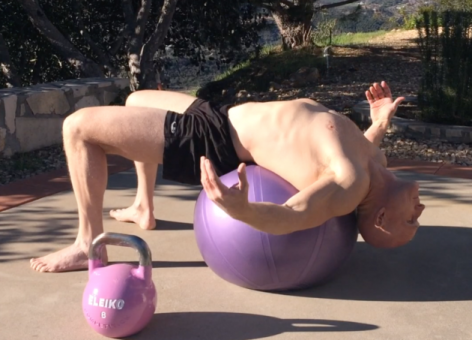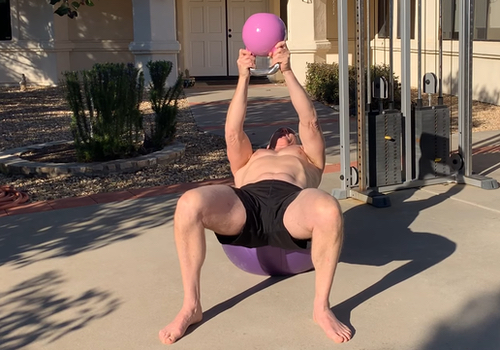A Swiss Ball and a Kettlebell
Happy Monday and welcome back to my blog/vlog.
This week’s blog is a mix of exercises that you can use with a kettlebell (thanks Eleiko!) or medicine ball while sitting on a Swiss ball.
Here are a couple of important pointers to keep in mind:
- Don’t work too quickly unless you’re in good condition, have a lot of body awareness and you’re properly warmed up for it.
- When you’re doing sit-ups or crunches on the ground, remember that you’re training at less than half of the typical range of motion that you have when you are standing. Your spine can extend 35-45 degrees behind the mid-frontal plane, so when you’re doing abdominal work lying supine on the ground, you’re only training at a fraction of your full range of motion, (a lot like doing half of a biceps curl or partial squats). When you train over a Swiss ball you can extend behind the mid-frontal plane and much more effectively condition the abdominals fully.

For starters, try this variation I call a floor-to-floor crunch or sit-up. Lay over a Swiss ball and keep your hips pointing upward. If you let your hips drop, you won’t get the activation of the hip extensors, so the exercise won’t be nearly as effective.
Let the kettlebell drop gently which behind your back to the ground which guides your body through a full range of motion. Then, lift the kettlebell or medicine ball over your head, using its momentum to carry you forward and the weight to the ground in front of you.
After warming up with this variation, I’ll show you in my vlog how to perform the Russian Twist on a Swiss ball.
Be sure to let the weight move easily and stay relaxed so you can keep your head on the Swiss ball. The point is to allow the weight to stretch out your connective tissues, fascia and muscles. Do it slowly and let the load of the kettlebell be your private therapist and open up your joints.
You can perform this exercise more dynamically and faster, but be careful that you’re not allowing the weight to move your body all the way to the end range of motion. Too much inertia places too much torque on your joints and can hurt you.
The challenge here is to manage your motion even when you’re weighed down with a kettlebell by using your muscles. That’s why I make sure my core is activated by drawing in my belly button just enough to turn it on, but not so much that it locks in my breathing.

As your load and speed increases, you’ll need to draw your belly button in to counter-balance for those changes. Again, keeping your hips up controls the rotational torque and helps your hamstrings and glutes to work in integrative ways with your core.
(Need some help with your core? Think about taking one of my core conditioning classes, including Scientific Core Conditioning or Core Conditioning Exercises.)
This exercise is pretty versatile — there’s a number of options I’ll show you in my vlog — and it underscores just another beautiful reason to use a Swiss ball.
The challenge for you is to spend time exploring and listening to your body. Sometimes, your body will want to be lengthened and opened up, while other times you’ll want to work faster and harder.
If you want to learn a lot more about exercise, assessments and practical information, I hope you’ll consider my Exercise Coach program. It took years of study, clinical practice and researching exercise science to put this program together, and you won’t find anything like it anywhere else.
See you next week!
Love and chi,
Paul